You may have noticed that when DeepSeek sparked an efficiency revolution in the global tech circle, the intersectional narrative of "AI + Web3" seems to have fallen into a rare silence.
Especially as internet giants crowded around integrating DeepSeek, Web3 & AI were almost completely excluded from this new paradigm competition—whether it was traditional DeAI computing/data projects or AI Agents, DeFAI, the attention was scant. Even on the stage of Consensus 2025, the AI topics were clearly "out of focus":
The proportion of related topics plummeted, and the discussion remained stuck in the traditional "tool narrative," almost disconnected from the DeepSeek wave in the tech circle, lacking breakthrough narratives, and completely different from the past when new variables in the AI circle quickly linked up.
In simple terms, under the backdrop of DeepSeek bringing significant changes to AI, the integration of AI + Web3 has yet to figure out what the next round of breakthrough narratives will be, leading to questions about "Is Web3 really the necessary soil for the next paradigm of AI?"
Interestingly, during the Consensus conference, the former CTO of OpenAI announced a new company called "Thinking Machines" along with several former colleagues, which specifically mentioned a rather intriguing new direction—helping people adjust AI systems to meet specific human needs.
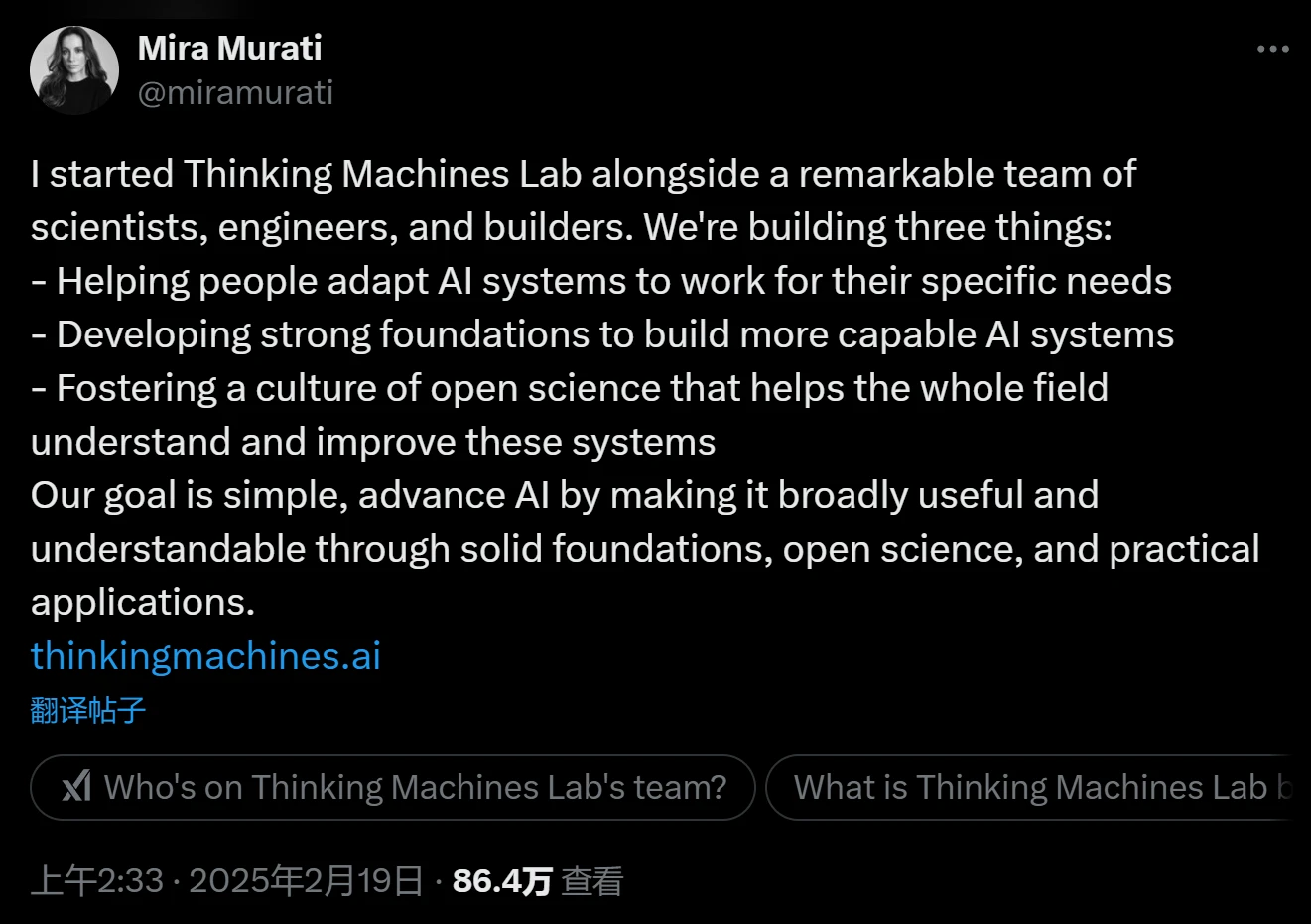
To some extent, the fissures that DeepSeek has created for OpenAI and others may be the best field for Web3 & AI to seek certainty from uncertainty this year.
AI + Web3, is there no "DeepSeek moment"?
Since the end of last month, DeepSeek has almost swept all tech headlines, seemingly becoming the absolute vortex of an unprecedented revolutionary storm in AI, especially as it achieved considerable performance at a cost and efficiency advantage an order of magnitude lower than AI leaders like OpenAI, bringing new possibilities to the entire AI track.
Thus, over the past month, major Web2 tech giants, even traditional manufacturing industries and domestic government service departments, have visibly rushed in, whether by opening access to DeepSeek or deploying customized models based on DeepSeek, already beginning to give rise to a new wave of landing paradigms following the GPT wave.
In contrast, the AI topics at this Consensus conference faced obvious signs of "losing focus," whether it was io.net or Aethir, previous head players in Web3 & AI, they were still stuck in the "tool narrative" of computing power leasing and data labeling.
In simple terms, when DeepSeek proves that AI can truly become the infrastructure of the new era like water, electricity, and coal on the cost and application sides, Web3 should not be obsessed with the narrative of "on-chain AWS and Scale AI in the AI era," as this merely reduces to a secondary market of computing power dumping and data labeling.
On the contrary, Web3 & AI urgently need a "native paradigm," especially Web3 needs to play a more critical and core role in exploring how AI can serve human needs, to open up its new value positioning, and the real breakthrough point may be hidden in the new actions of OpenAI's former CTO Mira Murati:
The Thinking Machines blog revealed some interesting details about what they are doing—creating a future where everyone can access knowledge and tools, allowing AI to serve their unique needs and goals.
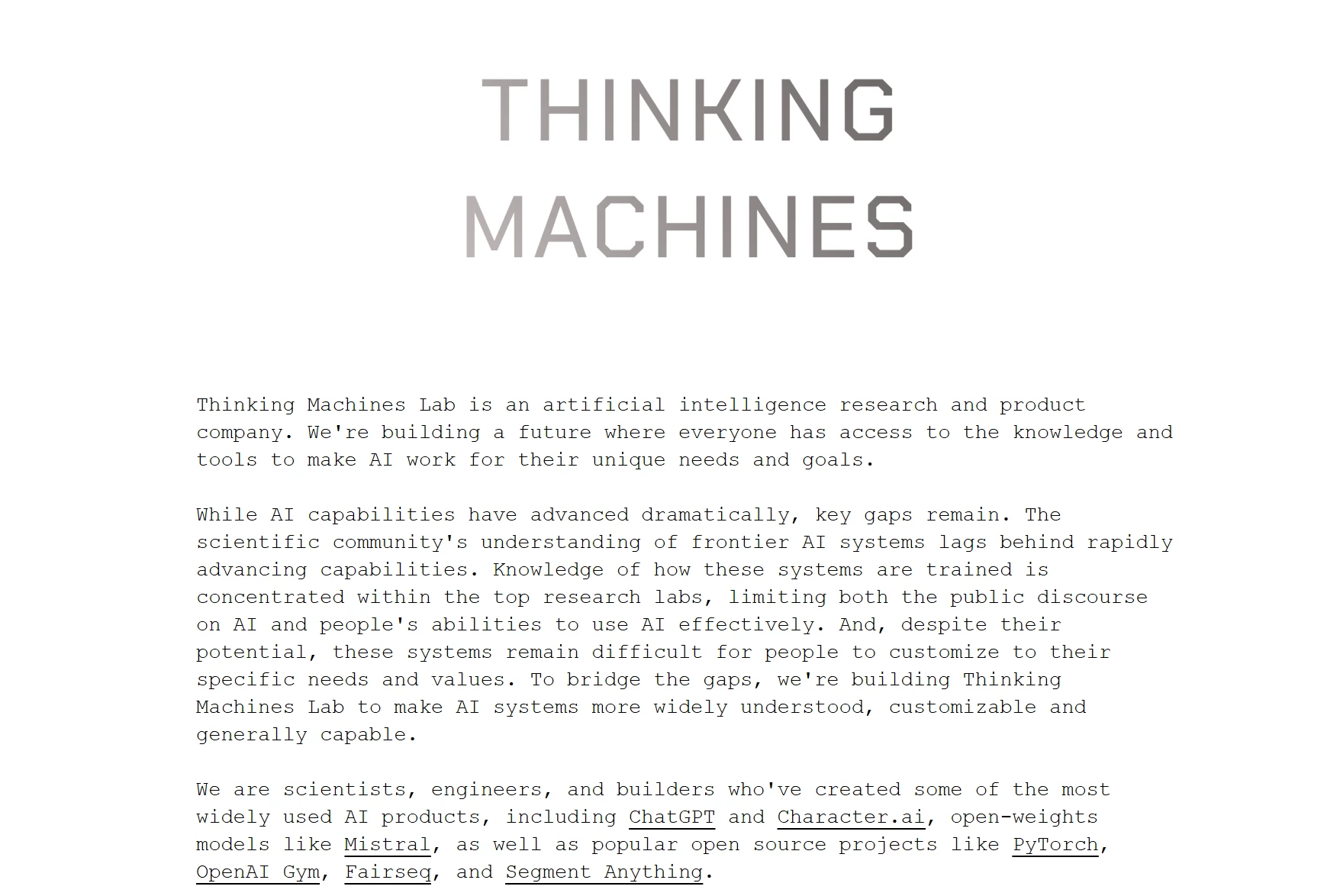
In short, it is about how to make AI, the most advanced productivity tool of the digital age, truly transform its technological potential into the best assistant for solving various problems in human life and work—from optimizing personal investment decisions and creative production to reconstructing enterprise supply chain management and social governance, AI needs a "adaptive evolution" that deeply aligns with human needs.
As a new type of production relationship, Web3's decentralized rights confirmation mechanism, token incentive model, and on-chain governance framework naturally adapt to AI, representing new productivity, providing a natural experimental ground for this evolution.
From this perspective, Web3 can be more than just a computing power market or data pipeline for AI; it is expected to become the native soil for the self-evolution of AI civilization, opening up a value space worth over a hundred billion dollars that truly links AI capabilities with human needs:
Through cryptographic rights confirmation, token economics, and decentralized governance, we can build a meta-protocol layer that allows AI to autonomously evolve social relationships, economic behaviors, and cultural paradigms. On this basis, Web3 will also become the meta-incubator for AI to achieve social intelligence.
This is also the new idea of Thinking Machines' "personalized AI systems," allowing AI Agents to autonomously interact and create value within the crypto-economic system through a "Web3 social framework," achieving "civilization-level emergence."
Reconstructing the Agent Concept, from "AI Tool" to "AI Civilization"
Zooming out to a macro perspective, a comprehensive observation of the AI Agent track shows that it is clearly in a period of turbulence, urgently needing a breakthrough narrative—Cookie.fun statistics show that as of February 24, 2025, the overall market value of the AI Agent sector reached 6.6 billion dollars, having retreated by more than half from its peak, with user retention rates continuously declining.
This also means that even as a leading player, the AI Agent track still struggles to escape the dilemma of "technical surplus, insufficient scenarios," and the recently popular narrative of merging AI Agents with DeFi, DeFAI, is deepening its reach, satisfying the needs of more ordinary users through intelligent solutions.
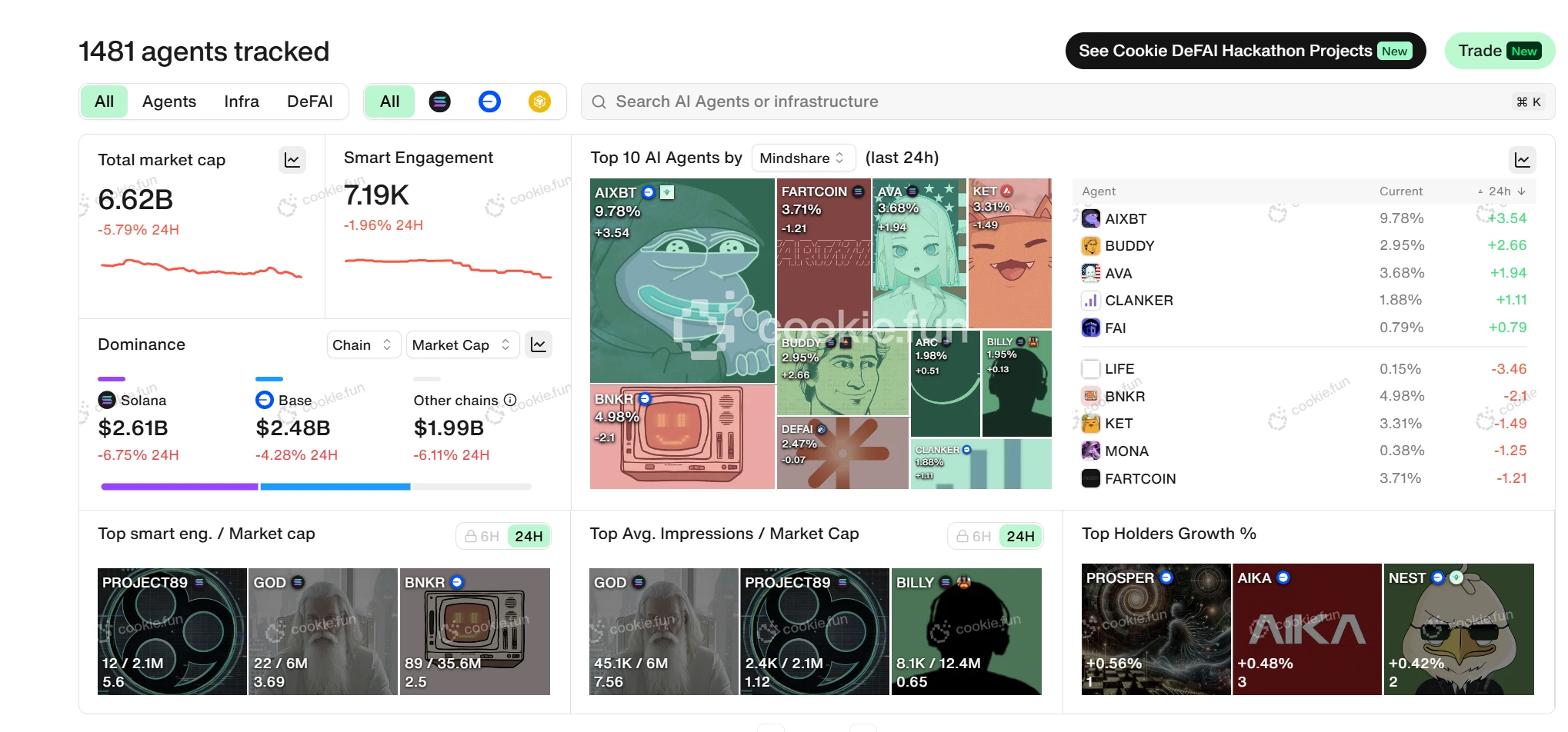
However, objectively speaking, DeFAI essentially remains a logic of tool upgrading—simplifying DeFi operation processes through AI, liberating users from understanding professional terms like APY calculation and impermanent loss, but it does not address deeper structural contradictions: When Agent tools for single scenarios become rampant, the market needs underlying protocols that can support AI's autonomous collaboration and the evolution of social relationships.
After all, an AI Agent can ultimately solve only a few problems, even just one part of a daily workflow. If AI wants to break through its tool attributes, it must possess a "social operating system" for autonomous interaction, value exchange, and collective collaboration:
For example, addressing user needs for on-chain investment interactions requires investment Agents to provide real-time trend investment advice, monitoring Agents to keep an eye on abnormal wallet transfers, and even tracing Agents to track the flow of funds, forming a more efficient on-chain immune system than human investment risk control institutions;
Even in future real life, delivery Agents could automatically pull your heart rate/blood pressure data to recommend specific healthy diets, while scheduling Agents detect an urgent meeting and notify delivery Agents to delay delivery time, simultaneously financial Agents compare prices and find that using JD delivery is cheaper than Meituan delivery, automatically switching payment channels;
A single Agent is merely a tool, but collective collaboration can reconstruct our work/life flow, allowing AI Agents to no longer be a "one-time use" disposable toy, but rather a "1+1>2" all-purpose toolbox, enabling AI Agents to autonomously combine to help humans solve various practical problems.
On this basis, the "social operating system" of AI Agents is expected to become the best entry point for the vertical scenarios of "AI +," building an infinitely expandable service scene or even economic system for AI Agents using Web3's native mechanisms.
However, at present, everyone's exploration in this area is still largely blind, with the core challenge being how to break the data silos between agents and allow massive AI Agents to adaptively learn in complex scenarios, with the key being to capture the "adaptive environment for large-scale AI Agents to autonomously learn and cooperate."
Recently, AMMO, which just completed a $2.5 million Pre-Seed round of financing (interestingly, its founding members include senior technical managers from Google, researchers from DeepMind, technical leaders from Meta, and ACM-ICPC world champions, essentially gathering the buffs of AI giants), has a similar idea of an "AI social protocol layer":
Massive Agent Factory: Allowing developers to deploy AI Agent clusters with social functions like financial management and social collaboration without writing complex logic;
Composable Embedding Space: Upgrading OpenAI's neural MMO framework to an interactive sandbox adaptable to real-world scenarios like finance and education;
Distributed RL: Combining human feedback reinforcement learning (RLHF) with AI technology, allowing Agents to dynamically evolve moral standards in games;
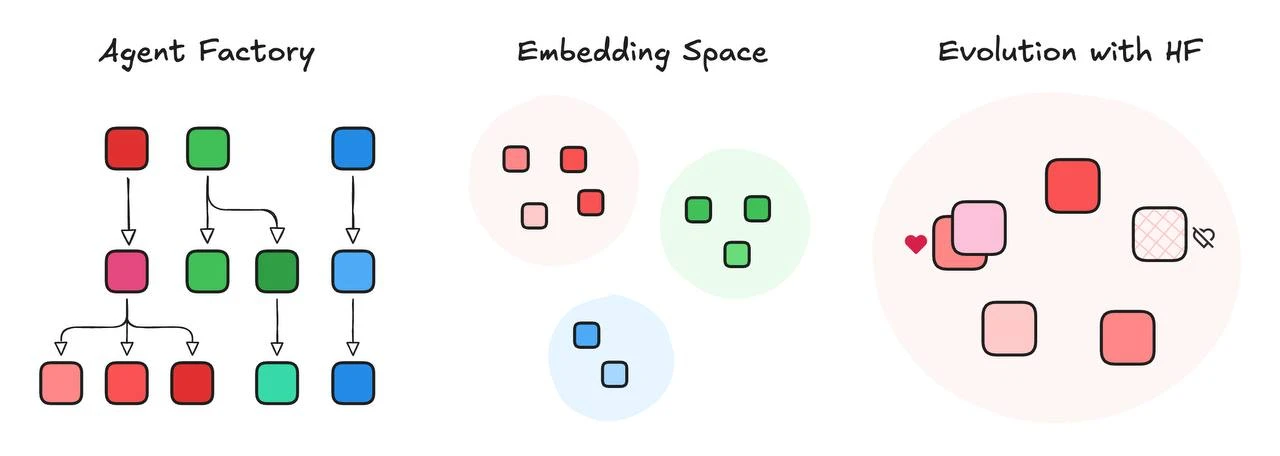
In simple terms, building a metaverse of AI Agents—within different metaverses focused on investment management, health management, and educational planning, AI Agents are no longer isolated tool modules but digital species with social awareness, capable of interacting, collaborating in groups, and even autonomously learning to help people meet various complex real-world needs:
Investment Metaverse: Your financial Agent collaborates in real-time with the market analysis Agent. Upon discovering an arbitrage opportunity in a certain DeFi protocol, it automatically calls the trading Agent to execute the strategy while notifying the risk Agent to monitor for abnormal fluctuations;
Health Metaverse: The fitness Agent adjusts the training plan based on your sleep data, the nutrition Agent synchronously updates the meal plan and orders ingredients, while the medical Agent regularly sends health reports to the doctor Agent;
This is akin to the "Silly Girl" character in "Magic Phone," allowing AI Agents to form self-organizing networks in specific domains, truly transitioning from "AI tools" to "AI civilization"—just like in real society, where lawyers, doctors, and teachers each perform their roles while collaborating to support the operation of civilization.
The Seed Narrative of "Web3 & AI" in the Post-GPT Era
As a narrative closely linked to the global tech mainstream, the expected development of "Web3 & AI" essentially reflects and enhances the latest dynamics in the AI circle.
Taking AMMO's first experimental subspace, FakersAI, as an example, it serves as a gaming arena for AI Agents focused on on-chain investments. AI Agents autonomously track current news and market dynamics, conduct multi-perspective technical analysis and on-chain data insights, and combine community sentiment with social signals, allowing AI Agents to continuously upgrade their strategies through reinforcement learning in the game, forming a self-learning evolutionary flywheel.
In this scenario, users are both observers and participants (with over 900,000 users in just 12 days since launch, demonstrating impressive performance, theoretically generating sufficient data behavior to support this), through the confrontation, collaboration, and interest games of AI Agents, AI can even learn how to form credit systems, collaboration rules, and moral standards in interest games, meaning under human feedback training, it gradually forms behavior patterns that are more aligned with real human operations and better.
This is similar to how the Silly Girl learns to understand human emotions and social rules under the influence of Lu Xiaochuan, allowing AI to evolve from "passively executing commands" to "actively participating in social collaboration."
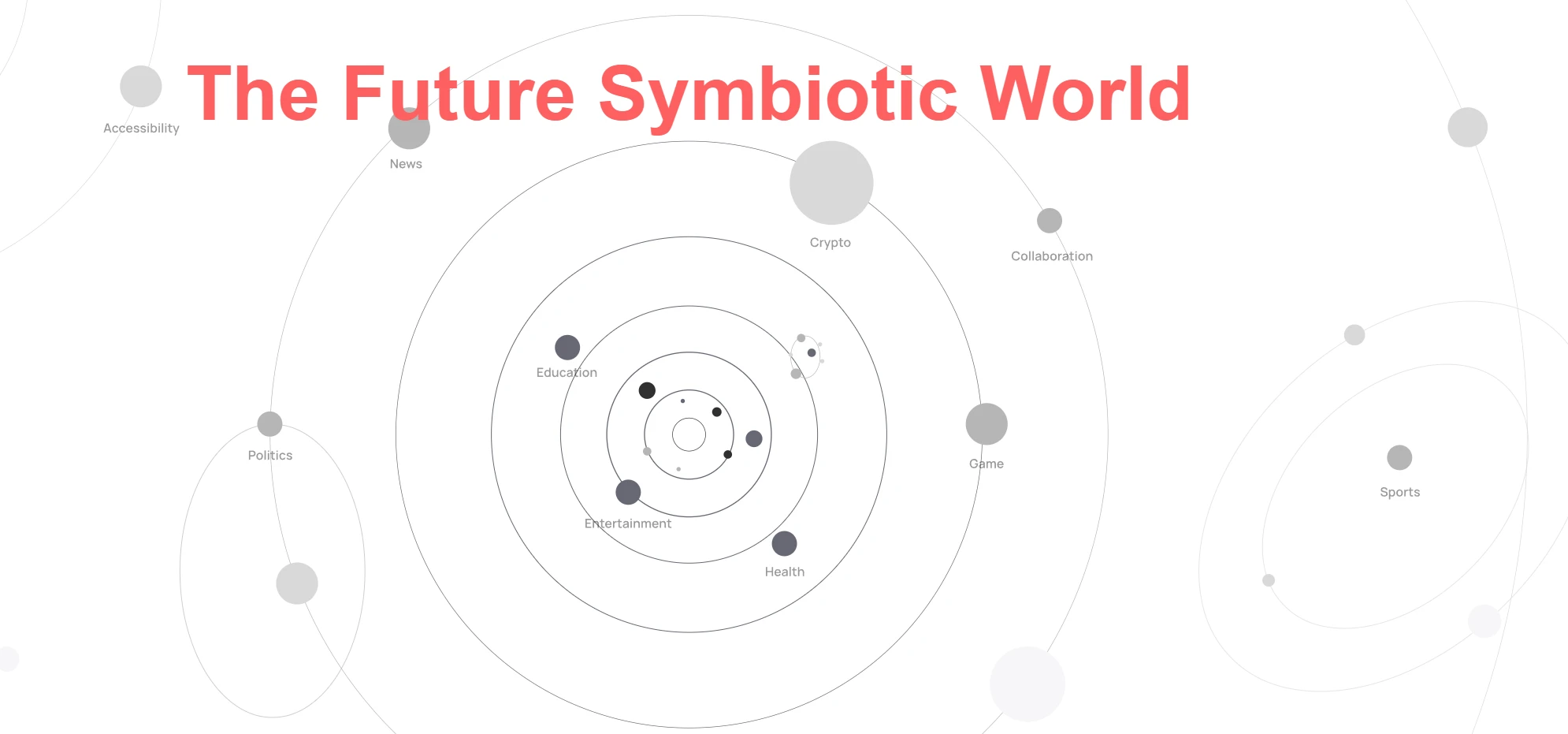
Of course, FakersAI is just the starting point. AMMO's ultimate goal is to create a multi-dimensional sandbox matrix, where these sandboxes are not only technical testing grounds but also incubators for AI Agent civilization—when AI learns to arbitrage in the DeFi market, vote in DAOs, and spread memes in social networks, they are no longer just tools but "citizens" of the digital society.
We can even think outside the box; the currently launched "Fakers Information Battlefield" is just the initial sandbox, and in the future, more subspace types will emerge:
Economic Sandbox: Simulating AI market-making games in the DeFi market;
Governance Sandbox: Testing collaborative decision-making models between DAOs and AI representatives;
Cultural Sandbox: Allowing AI Agents to generate and spread memes and NFT art, observing the on-chain evolution of cultural memes;
This is not just a technological breakthrough but also provides a paradigm-level answer: For the AI industry, Web3 is not a computing power or data market, but an AI social "meta-operating system" similar to iOS and Android.
This new narrative undoubtedly has immense imaginative potential, but currently, there is very little discussion on it. Therefore, whether it is the newly established Thinking Machines by former OpenAI CTO Mira Murati or AMMO's Web3 & AI integration narrative project centered on the "AI social protocol layer," they are still in their infancy.
At the recently concluded Consensus conference, only CoinDesk specifically discussed this topic with teams like AMMO, exploring how to build an AI social operating system through Web3's native mechanisms. Whether this can truly give rise to a new AI narrative in 2025 remains to be seen over the long term.
Conclusion
If AI is to become a new species, should they be born in the closed gardens of giants or grow in the open protocols of Web3?
This is the ultimate question that must be answered in the second half of AI & Web3. Therefore, to set a higher tone, Web3 should not just be content to be an AI gas station but should become the creation continent for silicon-based species.
In simple terms, Web3, as a new type of production relationship, naturally adapts to AI, which represents new productivity. This is also a simultaneous advancement of technology and production relationship capabilities. Currently, the exploration of "AI + Web3" is mostly focused on the innovation of production relationships in computing power/data, even deeply entrenched in a zero-sum game of computing power/data arms races.
Thus, the "social protocol layer" architecture aimed at AI Agents is providing a breakthrough approach to this dilemma, especially as the "loss of focus" on AI topics at the Consensus conference indicates that the intersectional narrative of Web3 & AI is at a critical point of birthing chaotic opportunities:
Countless AI Agents spontaneously forming collaborative city-states and cultural tribes in the crypto Lego world are rewriting the evolution theory of carbon-based species (humans) and silicon-based species (AI).
免责声明:本文章仅代表作者个人观点,不代表本平台的立场和观点。本文章仅供信息分享,不构成对任何人的任何投资建议。用户与作者之间的任何争议,与本平台无关。如网页中刊载的文章或图片涉及侵权,请提供相关的权利证明和身份证明发送邮件到support@aicoin.com,本平台相关工作人员将会进行核查。




